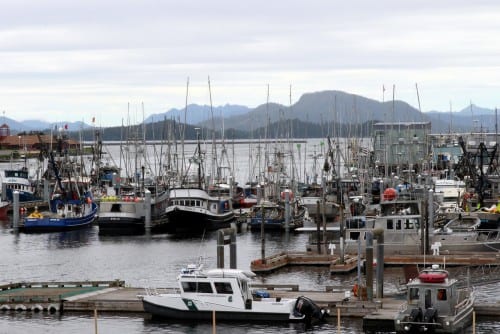
Sitka’s ANB harbor in 2015. By 2056 the city can expect to pay almost $75 million to maintain and replace harbors — which means a 6-percent increase for users now. (KCAW file photo)
The Sitka assembly combed through the finances of the Electric Department and Harbors, but could find no relief for rate payers facing higher bills next year and into the future.
In his summary, municipal finance director Jay Sweeney told the assembly that “capital plans drive the fee increases, but that doesn’t mean that fee increases are politically palatable.”
The assembly last Tuesday increased electrical rates by 15-percent. They’ll be asked to increase water rates 3-percent a year from 2018 to 2020, and then almost 4-percent a year through 2026.
Similar increase schedules are being proposed for some of Sitka’s other enterprise funds, including Wastewater and Solid Waste.
A 6-percent increase in user fees is being proposed for Harbors, in order to generate working capital sufficient to maintain Sitka’s existing harbor system, as then replace it. Eliason Harbor, the boat grid, and the Crescent Harbor high load dock are all scheduled for replacement in the next 15 years, at a cost of over $31 million.
The same rationale is built into all the increases: in order to maintain Sitka’s existing infrastructure, the community can either save money now, or risk failure.
Mayor Matt Hunter said he had about reached the point where he would suffer a power outage of a day or two, in order not to have to increase electric rates.
Utility director Bryan Bertacchi responded, “What about Sea Mart, or the fish processors?” He suggested that sustained power outages could have devastating effects on Sitka’s businesses and the economy.
There was a similar exchange over roads. Member Bob Potrzuski asked if there would be a savings in allowing Sitka’s streets to return to gravel. Public works director Michael Harmon said that there would indeed be a small savings over the service life of a street if it were unpaved, but he questioned whether Sitkans would tolerate it. “For a lot of people,” he said, “a car is a big investment.”
Although the rate increases seem severe, finance director Sweeney cautioned that Sitka had been insulated for decades by state funding.
He pointed out that an electric customer in 1993 who paid $314 for 2,500 kilowatt-hours of electricity, only paid $7 more for the same amount in 2011 — an increase of 2.3 percent over 18 years.
The consumer price index, however, rose by over 30-percent in the same period.
“I don’t know what conclusions you want to draw from that,” Sweeney said, “But there is a disparity.”
The assembly took no action concerning Sitka’s enterprise funds. They will resume their discussion on April 16.






























